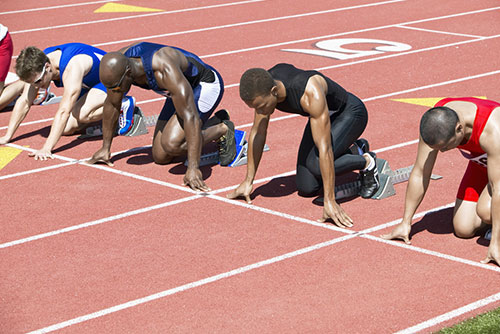
In track and field, there is a wide range of sports that can challenge your body. From throwing, to running, to jumping, you probably put lots of strain on your body as a track and field athlete. This means that certain kinds of injuries might be more common for you, especially joint injuries. The most common track and field injuries are plantar fasciitis, muscle strains, and Achilles tendinitis.
Achilles Tendinitis
Damage to your Achilles tendon can be caused by many things, including:
- Inflammation
- Ruptures
- Overuse Injuries
- Tendon Degeneration
- Inflammation in the Tendons
- Stress Injuries from Running and Jumping
Achilles tendinitis is a common condition that will cause stiffness and pain along your Achilles tendon, especially when you have just gotten up for the day. You might also have pain in the back of your heel and notice it is getting worse over time. The Achilles tendon is a structure that connects your heel and calf muscle together. With Achilles tendinitis, the tendon sometimes may become thicker.
To stop yourself from getting Achilles tendinitis, it is a good idea to gradually increase the intensity of your training, instead of working hard right off the bat. In addition, you should wear the right shoes and get enough rest. Look for shoes that have arch support. It also is good to cross-train in different areas, especially with lower-impact sports, like cycling or swimming.
Muscle Strains
One of the most common kinds of muscle strains is a hamstring strain. Often, you’ll have severe and sudden pain during a workout if you have strained your hamstring. You might notice a popping or a snapping feeling, as well as pain in the lower buttock and thigh when you are walking. You might notice bruising and tenderness and have pain when you are bending over or straightening your leg.
To prevent this kind of strain, you should stop if you feel any muscle pain. Make sure that you stretch before a workout and warm up properly. When it is cold outside, you will need some extra time to warm up. Try to strengthen the hamstring muscles and balance it out by also strengthening out your quadriceps.
To treat this condition, you should place ice on the area and take anti-inflammation medications. Physical therapy is important for healing and keeping the affected muscle strong.
Plantar Fasciitis
If you run, then the hard pounding motions can damage the ligaments on the soles of your feet. That can result in heel pain that prevents you from jumping or running. When you have plantar fasciitis, you might feel a stabbing pain in your feet near the heels. This is often worse in the early morning, and it can also happen after sitting or standing for a long period of time. Usually, you will experience the worst pain after a workout.
To prevent the condition, you should care for your feet by doing exercises to strengthen your Achilles tendon near the back of your heel. It also is important to have a healthy weight for your height and have good exercise habits.
Treating plantar fasciitis involves resting the feet and putting ice on the heel. It is important to have shoes with good arch support and shock absorption. Ask your orthopedist if wearing special shoe inserts is right for you.
Closing Thoughts
When you participate in track and field, you are at risk for certain injuries. The good news is that by visiting us at Prairie Orthopedic, we can help you prevent the most common track and field injuries and also help you to a speedy recovery. If you think you might be suffering from one of these injuries, please give us a call at or visit our website at https://www.prairie-ortho.com/.

